belt PONTIAC GRAND-PRIX 1993 Owners Manual
[x] Cancel search | Manufacturer: PONTIAC, Model Year: 1993, Model line: GRAND-PRIX, Model: PONTIAC GRAND-PRIX 1993Pages: 338, PDF Size: 17.3 MB
Page 2 of 338
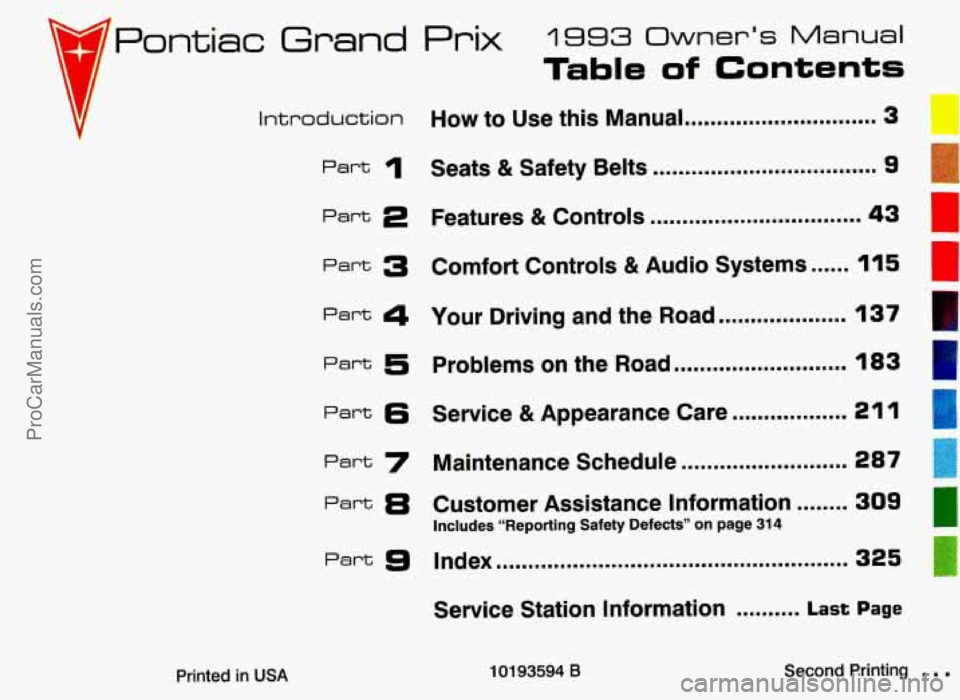
BPontiac Grand Prix 1993 Owner’s Manual
Table of Contents
Introduction How to Use this Manual .............................. 3
Part 1 Seats & Safety Belts ................................... 9
Part 2 Features & Controls ................................. 43
Part 3 Comfort Controls & Audio Systems ...... 115
Part 4 Your Driving and the Road .................... 137
Part 5
Part 6
Part 7
Part 8
Part B
Problems on the Road ........................... 183
U
t
ti
II
Service & Appearance Care .................. 211
Maintenance Schedule .......................... 287
Customer Assistance Information ........ 309
Index ....................................................... 325
Includes “Reporting Safety Defects” on page 314
Service Station Information .......... Last Page
II
n
Printed in USA 101 93594 B Second Printing . .
ProCarManuals.com
Page 4 of 338
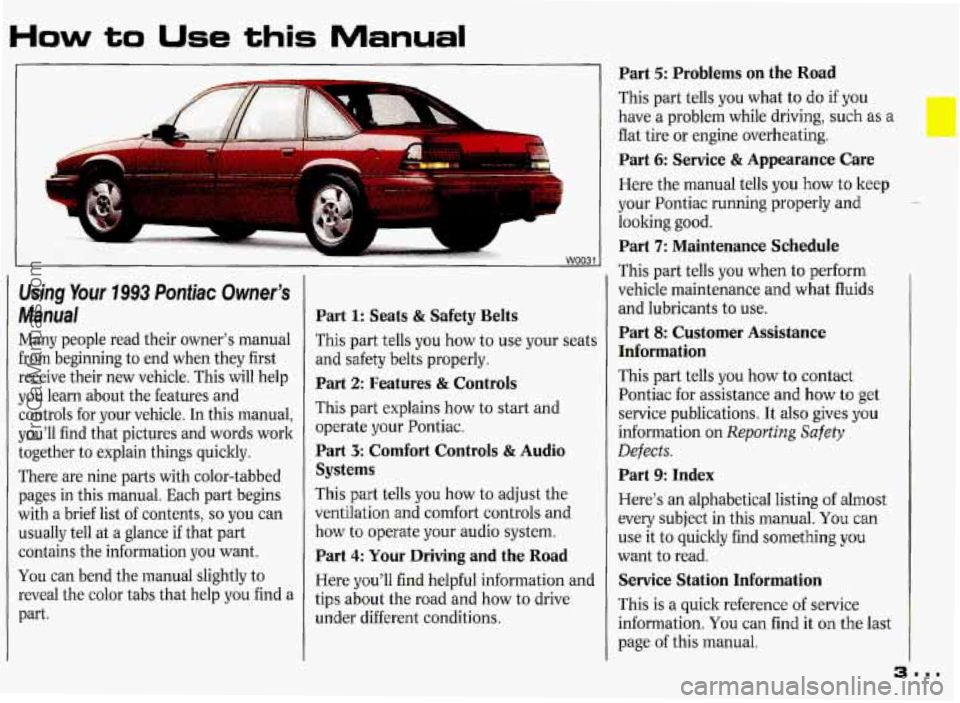
How to Use this Manual
b
Using Your 1993 Pontiac Owner’s
Manual
Many people read their owner’s manual
from beginning to end when they first
receive their new vehicle. This will help
you learn about the features and
controls for your vehicle. In this manual,
you’ll find that pictures and words work
together to explain things quicltly.
There are nine parts with color-tabbed pages in this manual. Each part begins
with a brief list of contents,
so you can
usually tell at a glance if that part
contains the information you want.
You can bend the manual slightly to
reveal the color tabs that help you find a
part.
Part 1: Seats & Safety Belts
This part tells you how to use your seat:
and safety belts properly.
Part 2: Features 8z Controls
This part explains how to start and
operate your Pontiac.
Part 3: Comfort Controls & Audio
Systems
This part tells you how to adjust the
ventilation
and comfort controls and
how to operate your audio system.
Part 4: Your Driving and the Road
Here you’ll find helpful information anc
tips about the road and how to drive
under different conditions.
Part 5: Problems on the Road
This part tells you what to do if you
have a problem while driving, such as a
flat tire or engine overheating.
Part 6: Service & Appearance Care
Here the manual tells you how to keep
your Pontiac running properly and
looking good.
Part 7: Maintenance Schedule
This part tells you when to perform
vehicle maintenance and what fluids
and lubricants to use.
Part 8: Customer Assistance
Information
This part tells you how to contact
Pontiac for assistance and how
to get
service publications. It also gives you
information on
Reporting Safety
Defects.
Part 9: Index
Here’s an alphabetical listing of almost
every subject in this manual.
You can
use it to quicltly find something
you
want to read.
Service Station Information
This is a quick reference of service
information.
You can find it on the last
page of this manual.
~~.
ProCarManuals.com
Page 6 of 338
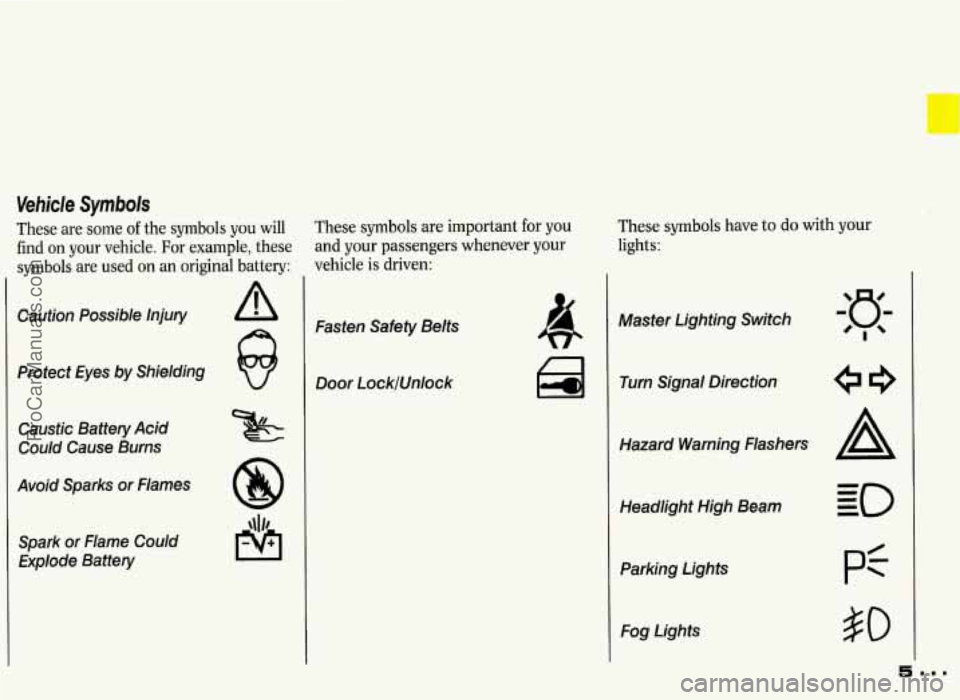
c
Vehicle Symbols
These are some of the symbols you will
find on your vehicle. For example, these
symbols are used
on an original battery:
I
Caution Possible Injury
Protect Eyes by Shielding
Caustic Battery Acid
Could Cause Burns
Avoid Sparks
or Flames
Spark or Flame Could
Explode Battery
These symbols are important for you
and your passengers whenever your
vehicle is driven:
Fasten Safety Belts
Door LocklUnlock
These symbols have to do with your
lights:
a Turn Signal Direction
Hazard Warning Flashers
Headlight High Beam
Parking Lights Fog Lights
ProCarManuals.com
Page 10 of 338
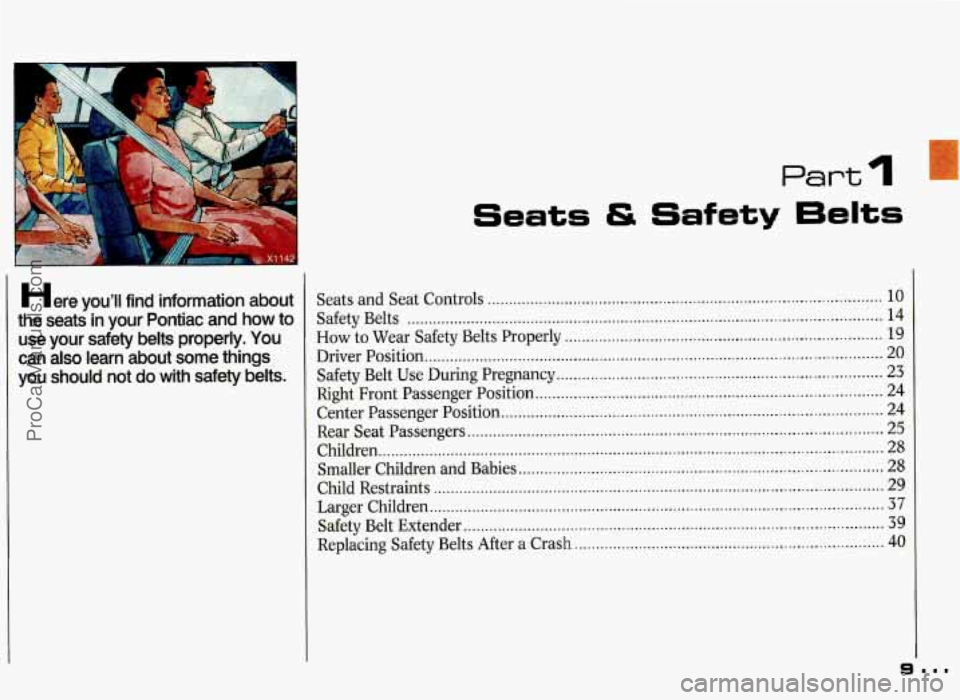
Part 1
Here YOU'II find information about
the seats in your Pontiac and
how to
use your safety belts properly
. You
can also learn about some things
you should not
do with safety belts .
Seats & Safety 6elts
Seats and Seat Controls ........................................................................\
.................... 10
Safety Belts ........................................................................\
....................................... 14
How to Wear Safety Belts Properly ........................................................................\
.. 19
Driver Posltlon
safety Belt Use During Pregnancy
........................................................................\
.... 23
Right Front Passenger Position
........................................................................\
......... 24
Center Passenger Posltlon
........................................................................\
................ -24
Rear Seat Passengers ........................................................................\
......................... 25
Children
........................................................................\
.............................................. 28
Smaller Children and Babies
........................................................................\
............. 28
Child Restraints
........................................................................\
................................. 29
Larger Children
........................................................................\
.................................. 37
Safety Belt Extender ........................................................................\
.......................... 39
Replacing Safety Belts After a Crash
........................................................................\
40
.. ........................................................................\
................................... 20
..
..
ProCarManuals.com
Page 14 of 338
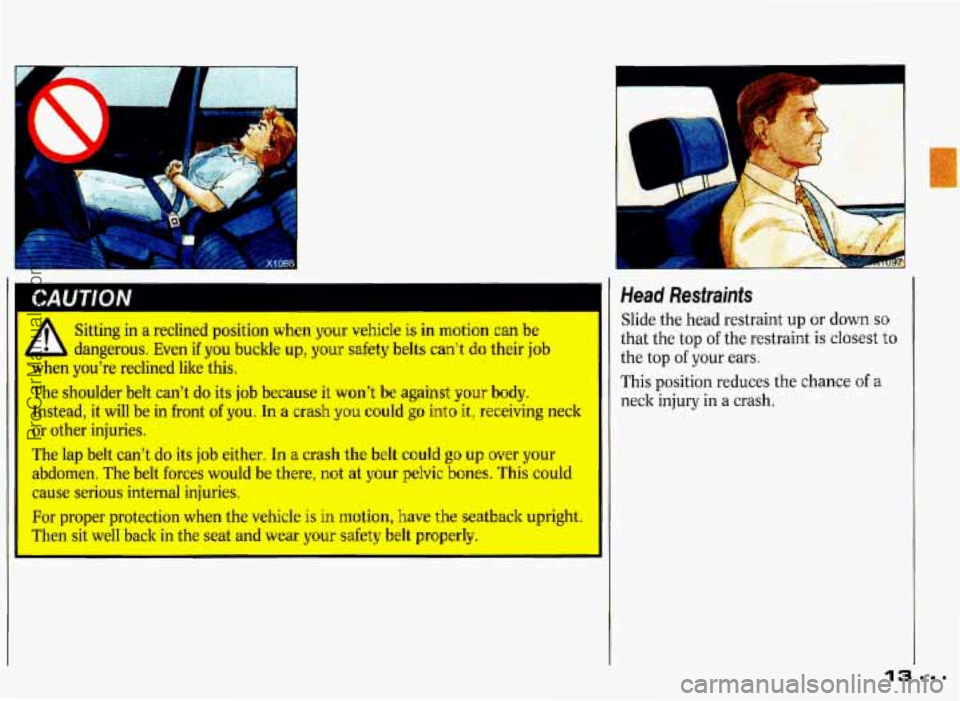
P
CAUTION
Sitting in a reclined position when your vehicle is in mation can be
L dangerous. Even if you buckle up, your safety belts can’t do their job
mllGn you’re reclined like this.
The shoulder belt can’t do its job because it won’t be against ~LU- body.
Instead, it will be in front of you. In a crash you could go into it, receiving neck
or other injuries.
The lap belt can’t do its job either. In a crash the belt could go up over your
abdomen. The belt forces would be there, not at your pelvic bones. This could
cause serious internal injuries.
For proper protection when the
vehicle is in motion, have the seatback upright.
Then sit well back in the seat and wear your safety belt properly.
n
t
b L. .
Head Restraints
Slide the head restraint up or down so
that the top of the restraint is closest to
the top
of your ears.
This position reduces the chance of a
neck injury in a crash.
ProCarManuals.com
Page 15 of 338
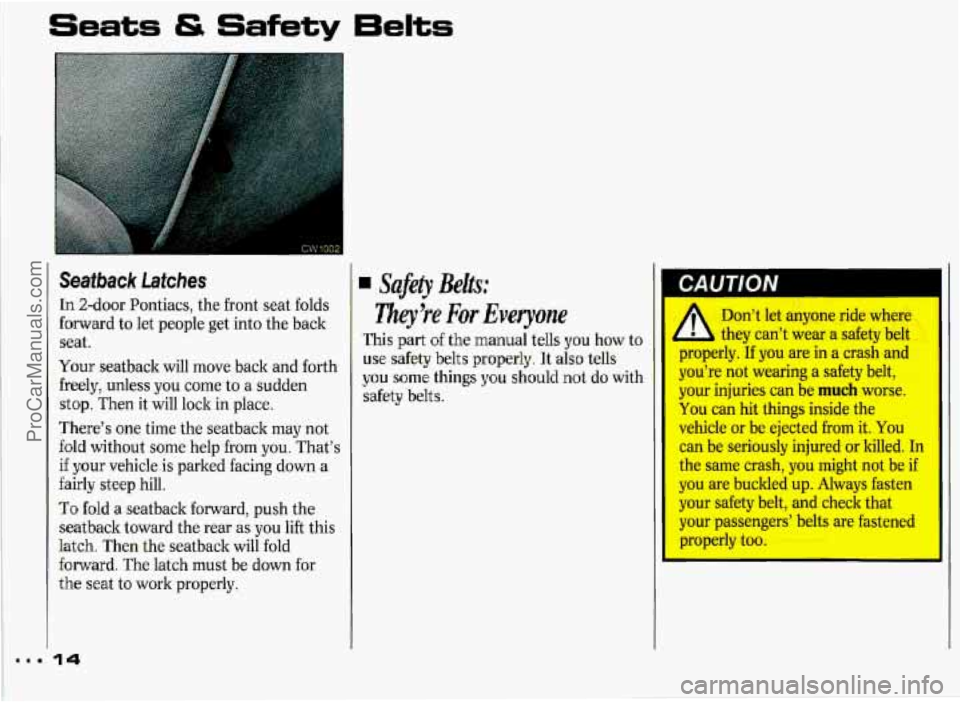
Seats & Safety Eelts
I’
Seatback Latches
In 2-door Pontiacs, the front seat folds
forward to let people get into the back
seat.
Your seatback will move back and forth
freely, unless you come to a sudden
stop. Then it will lock in place.
There’s one time the seatback may not
fold without some help from
you. That’s
if your vehicle is parked facing down a
fairly steep hill.
TQ fold a seatback forward, push the
seatback toward the rear as you
lift this
latch. Then the seatback will fold
forward. The latch must be down for
the seat to work properly.
4 Safety Belts:
They’ve For Everyone
This part of the manual tells you how to
use sakty belts properly. It also tells
you mme things you should not do with
s’afety belts .
14
Don’t let anyone ride where I L
- they can’t wear a safety belt
properly.
If you are in a crash and
you’re not wearing a safety belt,
your injuries can be
much worse.
You can hit things inside the
vehicle or be ejected from it.
You
can be seriously injured or killed. In
the same crash, you might not be
if
you are buckled up. Always fasten
your safety belt, and check that
your passengers’ belts are fastened
properly too.
ProCarManuals.com
Page 16 of 338
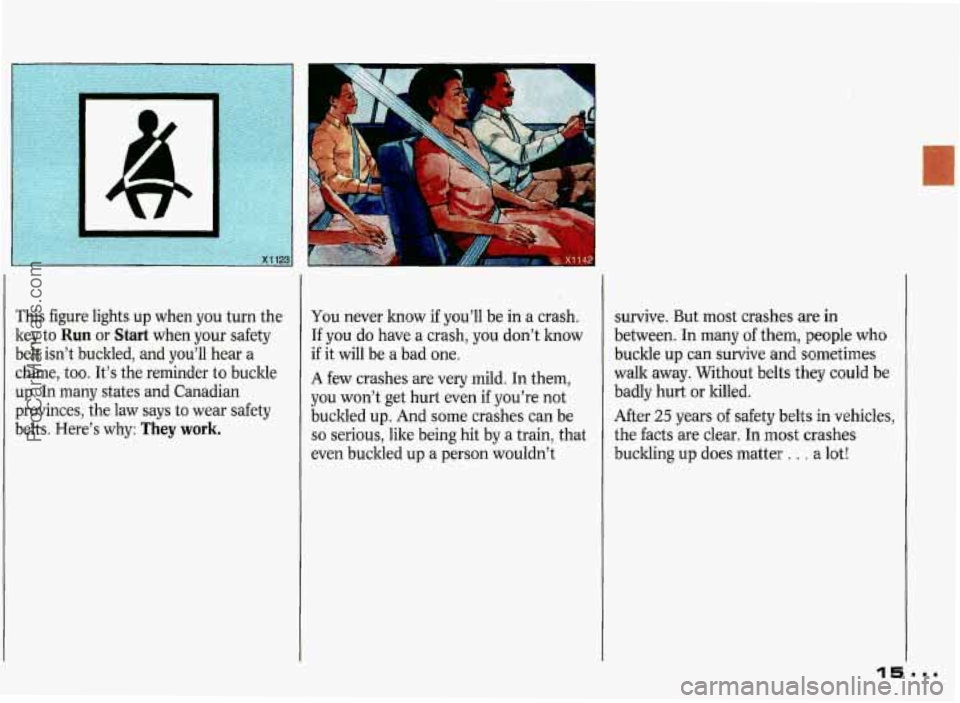
This figure lights up when you turn the
key to
Run or Start when your safety
belt isn’t buckled, and you’ll hear a
chime, too. It’s the reminder to buckle
up.
In many states and Canadian
provinces, the law says to wear safety
belts. Here’s why:
They work.
You never know if you’ll be in a crash.
If you do have a crash, you don’t know
if it will be a bad one.
A few crashes are very mild. In them,
you won’t get hurt even if you’re not
buckled
up. And some crashes can be
so serious, like being hit by a train, that
even buckled
up a person wouldn’t survive. But
most crashes are in
between. In many
of them, people who
buckle up can survive and sometimes
walk away. Without belts they could
be
badly hurt or killed.
After
25 years of safety belts in vehicles,
the facts are clear.
In most crashes
buckling
up does matter . . . a lot!
ProCarManuals.com
Page 17 of 338
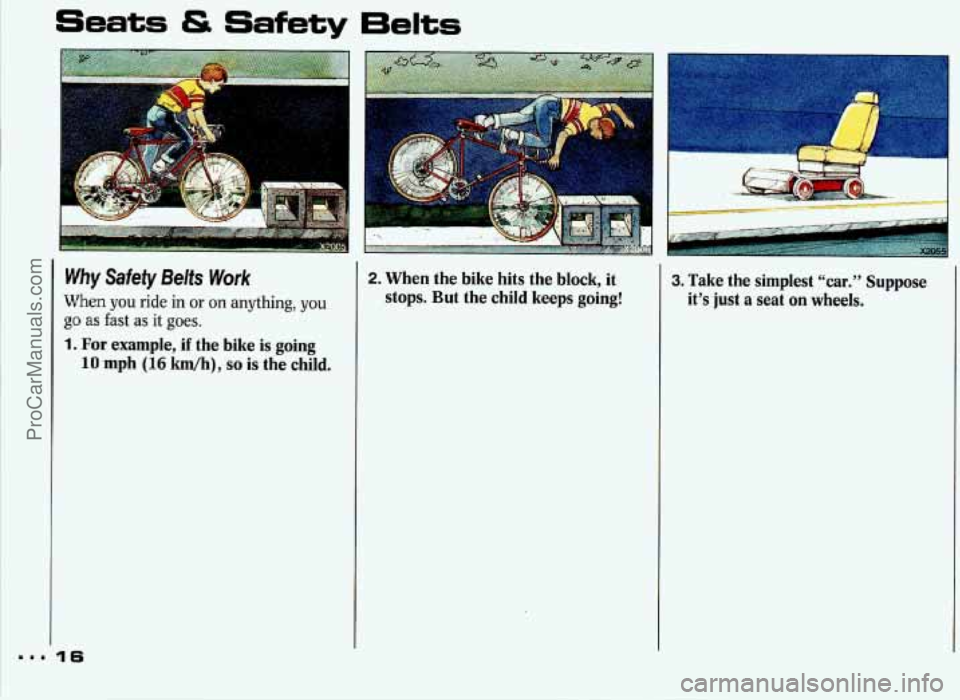
Seats & Safety 6elts
Why Safety Belts Work
When you ride in or on anything, you
1. For example, if the bike is going
as fast as it goes.
10 mph (16 km/h), so is the child.
2. When the bike hits the block, it
stops. But the child keeps going! 3. Take the simplest “car.” Suppose
it’s just a seat on wheels.
ProCarManuals.com
Page 18 of 338
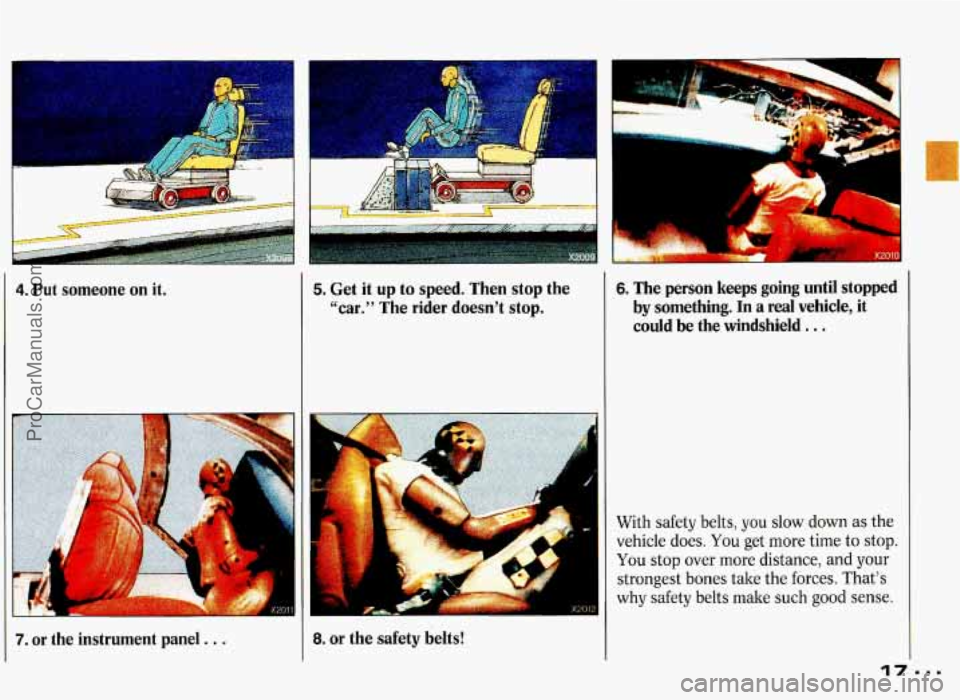
4. Put someone on it.
1r I
7. or the instrument panel . . .
5. Get it up to speed. Then stop the
“car.” The rider doesn’t stop.
I 8. or the safety belts!
x2012
6. The person keeps going until stopped
by something. In a real vehicle, it
could be the windshield.
. .
With safety belts, you slow down as the
vehicle does. You get more time to stop.
You stop over more distance, and your
strongest bones take the forces. That’s
why safety belts make such good sense.
ProCarManuals.com
Page 19 of 338
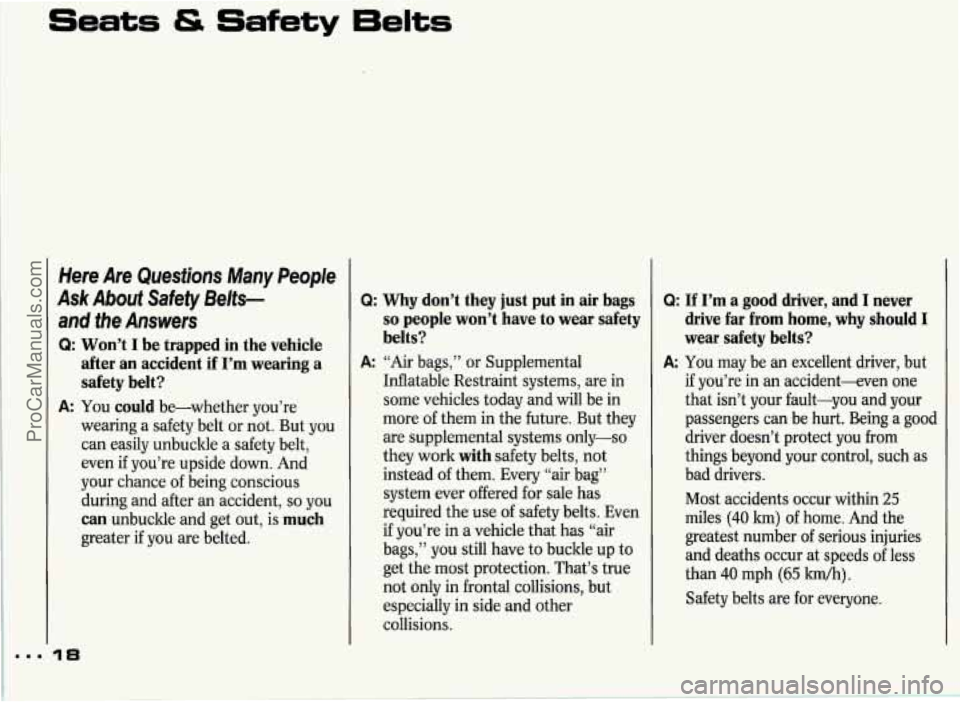
Seats 4S Safety 6eIts
Here Are Questions Many People
Ask About Safety 8elts-
and the Answers
Q: Won’t I be trapped in the vehicle
after an accident if I’m wearing a safety belt?
wearing a safety belt or not. But you
can easily unbuckle a safety belt,
even if you’re upside down. And
your chance of being conscious
during and after an accident,
so you
can unbuckle and get out, is much
greater if you are belted.
A: You could be-whether you’re
18
Q: Why don’t they just put in air bags
so people won’t have to wear safety
belts?
Inflatable Restraint systems, are in
some vehicles today and will be in
more
of them in the future. But they
are supplemental systems only-so
they work
with safety belts, not
instead
of them. Every “air bag”
system ever offered for sale has
required the use of safety belts. Even
if you’re in
a vehicle that has “air
bags,” you still have
to buckle up to
get the most protection. That’s true
not only in frontal collisions, but
especially in side and other
collisions.
A: “Air bags,” or Supplemental
Q: If I’m a good mver, and I never
drive
far from home, why should I
wear safety belts?
A: You may be an excellent driver, but
if you’re in an accident-even one
that isn’t your fault-you and your
passengers can be hurt. Being
a good
driver doesn’t protect
you from
things beyond your control, such as
bad drivers.
Most accidents occur within
25
miles (40 km) of home. And the
greatest number
of serious injuries
and deaths occur at speeds of less
than
40 mph (65 W).
Safety belts are for everyone.
ProCarManuals.com